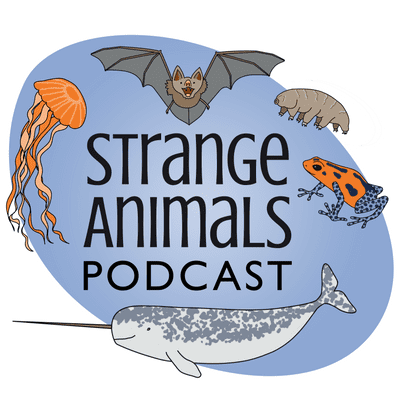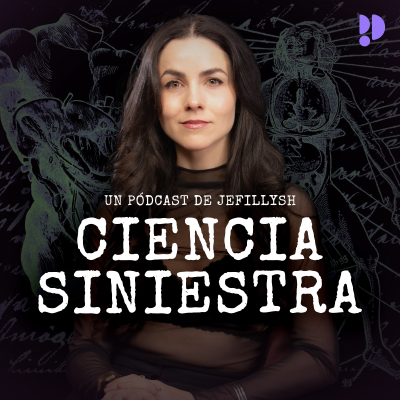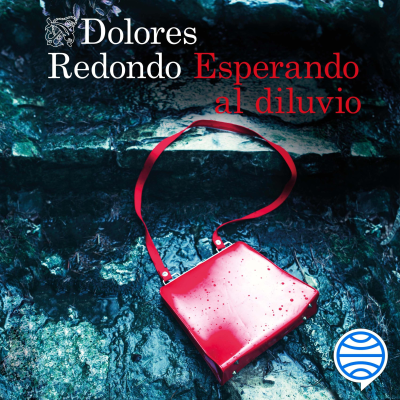
Strange Animals Podcast
Podcast de Katherine Shaw
Empieza 7 días de prueba
$99.00 / mes después de la prueba.Cancela cuando quieras.

Más de 1 millón de oyentes
Podimo te va a encantar, y no estás solo/a
Rated 4.7 in the App Store
Acerca de Strange Animals Podcast
A podcast about living, extinct, and imaginary animals!
Todos los episodios
446 episodiosThanks to Micah for suggesting this week’s topic, the trilobite! Further reading: The Largest Trilobites [https://www.amnh.org/research/paleontology/collections/fossil-invertebrate-collection/trilobite-website/the-trilobite-files/the-largest-trilobites] Stunning 3D images show anatomy of 500 million-year-old Cambrian trilobites entombed in volcanic ash [https://www.livescience.com/animals/extinct-species/stunning-3d-images-show-anatomy-of-500-million-year-old-cambrian-trilobites-entombed-in-volcanic-ash] Strange Symmetries #06: Trilobite Tridents [https://nixillustration.com/science-illustration/2023/strange-symmetries-06-trilobite-tridents/] Trilobite Ventral Structures [https://www.trilobites.info/trilovent.htm] A typical trilobite: [https://strangeanimalspodcast.blubrry.net/wp-content/uploads/2018/03/Trilobite-300x225-300x225.jpg] Isotelus rex, the largest trilobite ever found [photo from the first link above]: [https://strangeanimalspodcast.blubrry.net/wp-content/uploads/2025/07/isotelux-rex_full_610-211x300.jpg] Walliserops showing off its trident [picture by TheFossilTrade – Own work, CC BY-SA 4.0, https://commons.wikimedia.org/w/index.php?curid=133758014]: [https://strangeanimalspodcast.blubrry.net/wp-content/uploads/2025/07/500px-Walliserops_Trifurcatus_Trilobite_Fossil_TheFossilTrade-225x300.jpg] Another Walliserops individual with four prongs on its trident [photo by Daderot, CC0, via Wikimedia Commons]: [https://strangeanimalspodcast.blubrry.net/wp-content/uploads/2025/07/four-prong-trident-trilobite-225x300.jpg] Show transcript: Welcome to Strange Animals Podcast. I’m your host, Kate Shaw. This week we’re going to learn about an ancient animal that was incredibly successful for millions of years, until it wasn’t. It’s a topic suggested by Micah: the trilobite. Trilobites first appear in the fossil record in the Cambrian, about 520 million years ago. They evolved separately from other arthropods so early and left no living descendants, that they’re not actually very closely related to any animals alive today. They were arthropods, though, so they’re distantly related to all other arthropods, including insects, spiders, and crustaceans. The word trilobite means “three lobes,” which describes its basic appearance. It had a head shield, often with elaborate spikes depending on the species, and a little tail shield. In between, its body was segmented like a pillbug’s or an armadillo’s, so that it could flex without cracking its exoskeleton. Its body was also divided into three lobes running from head to tail. Its head and tail were usually rounded so that the entire animal was roughly shaped like an oval, with the head part of the oval larger than the tail part. It had legs underneath that it used to crawl around on the sea floor, burrow into sand and mud, and swim. Some species could even roll up into a ball to protect its legs and softer underside, just like a pillbug. Because trilobites existed for at least 270 million years, there were a lot of species. Scientists have identified about 22,000 different species so far, and there were undoubtedly thousands more that we don’t know about yet. Most are about the size of a big stag beetle although some were tinier. The largest trilobite found so far lived in what is now North America, and it grew over two feet long, or more than 70 centimeters, and was 15 inches wide, or 40 cm. It’s named Isotelus rex. I. rex had 26 pairs of legs, possibly more, and prominent eyes on the head shield. Scientists think it lived in warm, shallow ocean water like most other trilobites did, where it burrowed in the bottom and ate small animals like worms. There were probably other species of trilobite that were even bigger, we just haven’t found specimens yet that are more than fragments. Because trilobites molted their exoskeletons the way modern crustaceans and other animals still do, we have a whole lot of fossilized exoskeletons. Fossilized legs, antennae, and other body parts are much rarer, and preserved soft body parts are the rarest of all. We know that some trilobite species had gills on the legs, some had hairlike structures on the legs, and many had compound eyes. A specimen with preserved eggs inside was also found recently. Some incredibly detailed trilobite fossils have been found in Morocco, including details like the mouth and digestive tract. The detail comes from volcanic ash that fell into shallow coastal water around half a billion years ago. The water cooled the ash enough that when it fell onto the trilobites living in the water, it didn’t burn them. It did suffocate them, though, since so much ash fell that the ocean was more ash than water. The ash was soft and as fine as powder, and it covered the trilobites and protected their bodies from potential damage, while also preserving the body details as they fossilized over millions of years. The fossils were discovered in 2015, about 509 million years after the trilobites died, and are still being studied. Two species of trilobite have been found at this Morocco site, and the team is using non-invasive technology to study the preserved insides in one exceptionally preserved specimen. Its entire digestive system is intact, probably because the poor trilobite ended up swallowing a lot of ash before it died. The ash kept the soft tissues from decomposing. Some trilobites had spines growing from their head shields and even from the rest of the exoskeleton. Scientists think these may have helped protect the animals from being eaten, but they might also have helped them navigate more easily in the water without getting flipped over by currents. One genus of trilobite, Walliserops, even had a structure sticking out from the front of its head called a trident. The trident grew forward and slightly upward from the head, then split into three prongs. Scientists aren’t sure what it was for, but suggest that it acted as a nose spike like some modern beetles have, which allowed trilobites to fight each other for resources or mates. The tridents weren’t completely symmetrical, and one individual has even been found with a four-pronged trident. (I guess you would call that a quadrent.) Some species had long tridents, some short, but there’s no evidence that only males or only females had them. Electron microscopes and other modern imaging technology have allowed scientists to learn more about what the trilobite looked like when it was alive. This includes some hints about different species’ coloration and markings. Most trilobites had good vision and were probably as colorful as modern crustaceans. Some rare trilobite fossils show microscopic traces of spots and stripes. One species studied may have had a brown stripe that faded to white along the edges of the body. All trilobites went extinct at the end of the Permian, about 250 million years ago, during the extinction event called the Great Dying. We talked about it in detail in episode 227 so I won’t go over its causes and effects again except to say that an estimated 95% of all marine animals went extinct during that event. The Great Dying ended the trilobite’s successful 270 million year run on this amazing planet. When I was little, I found trilobites fascinating. They were so common for so long, and then they were gone. I’ve always wondered if some trilobites survived the Great Dying and were still alive in the deep sea. I’m not the only one who’s wondered that, so let’s talk a little more about why the trilobites went extinct and how some of them might have survived. Almost all trilobites we know of lived in shallow coastal water. We have trilobite tracks of an ancient low tide shore, which tells us that at least some species could leave the water and venture onto land occasionally, possibly the first animals on earth to do so. Coastal water is well oxygenated and we know trilobites had trouble surviving anoxic events, when the water where they lived had much less oxygen than usual. Anoxic events are actually what led to the Great Dying, but it wasn’t the first time the world’s oceans became less oxygenated. It happened in earlier extinction events too during the Devonian, around 372 and 359 million years ago, and each time many species and genera of trilobites went extinct. The trilobite was already in decline when the Great Dying occurred, with only a handful of genera left, and the extinction event finished them off once and for all according to the fossil record. But we do know of a few species of trilobite that were adapted to the deep sea. Deep-sea animals have to evolve to be tolerant of low-oxygen conditions. The deep sea is also very little known by humans. It’s possible, even if it’s unlikely, that deep-sea trilobites survived the Great Dying and that their descendants are still around, unknown to science. One interesting note, and an ongoing mystery about trilobites, is that while we know they were arthropods, we don’t actually know which branch of the phylum Arthropoda they’re most related to. That’s because there are no ancestral versions of the trilobite that have ever been found. When they appear in the fossil record, they’re already recognizably trilobites. It’s possible that the ancestral forms didn’t have exoskeletons that were likely to fossilize, or that we just haven’t found the right fossil bed yet. Until we learn more, it’ll remain a mystery. You can find Strange Animals Podcast at strangeanimalspodcast.blubrry.net. That’s blueberry without any E’s. If you have questions, comments, or suggestions for future episodes, email us at strangeanimalspodcast@gmail.com [strangeanimalspodcast@gmail.com]. We also have a Patreon at patreon.com/strangeanimalspodcast if you’d like to support us for as little as one dollar a month and get monthly bonus episodes. Thanks for listening!
Thanks to Cara for suggesting we talk about the long-beaked echidna this week! Further reading: Found at last: bizarre, egg-laying mammal finally rediscovered after 60 years [https://www.ox.ac.uk/news/2023-11-10-found-last-bizarre-egg-laying-mammal-finally-rediscovered-after-60-years] A short-beaked echidna: [https://strangeanimalspodcast.blubrry.net/wp-content/uploads/2017/12/echidna.jpg] The rediscovered Attenborough’s long-beaked echidna: [https://strangeanimalspodcast.blubrry.net/wp-content/uploads/2025/06/echidna-300x258.png] Show transcript: Welcome to Strange Animals Podcast. I’m your host, Kate Shaw. This week we’re going to learn about an animal suggested by Cara, the echidna, also called the spiny anteater. It’s a type of mammal, but it’s very different from almost all the mammals alive today. We talked about the echidna briefly in episode 45, but this week we’re going to learn more about it, especially one that was thought to be extinct but was recently rediscovered. Cara specifically suggested we learn about the long-beaked echidna, which lives only in New Guinea. The short-beaked echidna lives in New Guinea and Australia. The names short and long beaked make it sound like the echidna is a bird, but the beak is actually just a snout. It just looks beak-like from a distance and is covered with tough skin, sort of like the platypus’s snout is sometimes called a duck-bill. In June and July of 2023, an expedition made up of scientists and local experts from various parts of Indonesia, as well as from the University of Oxford in England, discovered and rediscovered a lot of small animals in the Cyclops Mountains. They even discovered an entire cave system that no one but some local people had known about, and they discovered it when one of the expedition members stepped on a mossy spot in the forest and fell straight through down into the cave. But one animal they were really hoping to see hadn’t made an appearance and they worried it was actually extinct. That one was Attenborough’s long-beaked echidna, a type of mammal known as a monotreme. There are three big groups of mammals. The biggest is the placental mammal group, which includes humans, dogs, cats, mice, bats, horses, whales, giraffes, and so on. A female placental mammal grows her babies inside her body in the uterus, each baby wrapped in a fluid-filled sac called a placenta. Placental mammals are pretty well developed when they’re born. The second type is the marsupial mammal group, which includes possums, kangaroos, koalas, wombats, sugar gliders, and so on. A female marsupial has two uteruses, and while her babies initially grow inside her, they’re born very early. A baby marsupial, called a joey, is just a little pink squidge about the size of a bean that’s not anywhere near done growing, but it’s not completely helpless. It has relatively well developed front legs so it can crawl up its mother’s fur and find a teat. Some species of marsupial have a pouch around its teats, like possums and kangaroos, but other species don’t. Once the baby finds a teat, it clamps on and stays there for weeks or months while it continues to grow. The third and rarest type of mammal these days is the monotreme group, and monotremes lay eggs. But their eggs aren’t like bird eggs, they’re more like reptile eggs, with a soft, leathery shell. The female monotreme keeps her eggs inside her body until it’s almost time for them to hatch. The babies are small squidge beans like marsupial newborns, and I’m delighted to report that they’re called puggles. There are only two monotremes left alive in the world today, the platypus and the echidna. The echidna has a pouch and after a mother echidna lays her single egg, she tucks it in the pouch. Monotremes show a number of physical traits that are considered primitive. Some of the traits, like the bones that make up their shoulders and the placement of their legs, are shared with reptiles but not found in most modern mammals. Other traits are shared with birds. The word monotreme means “one opening,” and that opening, called a cloaca, is used for reproductive and excretory systems instead of those systems using separate openings. It wasn’t until 1824 that scientists figured out that monotreme moms produce milk. They don’t have teats, so the puggles lick the milk up from what are known as milk patches. Before then a lot of scientists argued that monotremes weren’t mammals at all and should either be classified with the reptiles or as their own class, the prototheria. It’s easy to think, “Oh, that mammal is so primitive, it must not have evolved much since the common ancestor of mammals, birds, and reptiles was alive 315 million years ago,” but of course that’s not the case. It’s just that the monotremes that survived did just fine with the basic structures they evolved a long time ago. There were no evolutionary pressures to develop different shoulder bones or stop laying eggs. Other structures have evolved considerably. Monotremes aren’t closely related to any of the other mammals alive today, either marsupial or placental mammals. The last shared ancestor lived at least 163 million years ago and possibly much earlier, maybe even 220 million years ago. The first dinosaurs lived around 230 million years ago, so we are talking a very long time ago. The echidna is relatively closely related to the platypus and its ancestors probably looked and acted a lot like a platypus, including being largely aquatic. The echidna is adapted to life on land, even though it can swim quite well. It looks superficially like a big hedgehog since it’s covered in spines as well as hair, and if it feels threatened it will curl up into a ball like a hedgehog with its spines sticking out. It’s also a strong digger and will often dig a shallow hole very quickly when threatened, so that a potential predator encounters basically a bunch of spines sticking up out of the dirt. But unlike a hedgehog, which is usually small enough to fit in an adult human’s hand, the echidna can grow over 20 inches long, or 52 cm, and a big male can weigh as much as 13 lbs, or 6 kg. The echidna has a long, skinny snout with a pair of nostrils at the end. The snout is bare of fur and the echidna pokes it into the ground and leaf litter to find the worms and other small invertebrates it eats. Not only does it have a good sense of smell to locate food, its snout also contains electroreceptors that allow it to sense the tiny muscle movements of its prey. The short-beaked echidna mostly eats termites and ants, while the long-beaked echidna mostly eats earthworms. The echidna doesn’t have teeth and its mouth is tiny, but it has a long sticky tongue to lick up the animals it eats. The long-beaked echidna’s tongue has tiny spines on it, sort of like a cat’s tongue has tiny spines that help it groom its fur, but the spines on the echidna’s tongue help it stab worms and insect larvae and drag them into its mouth. Attenborough’s long-beaked echidna is a subspecies that was only discovered by scientists in 1961. It’s only known from a single specimen, and it hadn’t been seen since. In 2007 a scientific expedition found signs that an echidna was still living in the Cyclops Mountains, namely nose-pokes in the dirt where an echidna had been looking for food, but despite lots of searching for the animal, no one had seen it. Since the echidna is nocturnal and spends most of the day sleeping in its burrow, it’s hard to spot even under the best conditions. The 2023 expedition used over 80 trail cameras to try and find the echidna. The trail cams were set up for four weeks and not a single one recorded a single echidna—until the very last day, and even then it was almost the very last video on the memory card. It’s just a short little video of an echidna just walking along on its way to do echidna stuff, but it made a big difference for the scientists. Now that we know that Attenborough’s long-beaked echidna isn’t extinct, scientists can work with local people to help protect it and its habitat. You can find Strange Animals Podcast at strangeanimalspodcast.blubrry.net. That’s blueberry without any E’s. If you have questions, comments, or suggestions for future episodes, email us at strangeanimalspodcast@gmail.com [strangeanimalspodcast@gmail.com]. We also have a Patreon at patreon.com/strangeanimalspodcast if you’d like to support us for as little as one dollar a month and get monthly bonus episodes. Thanks for listening!
This week we’re going to learn about a new finding about the skull referred to as the Dragon Man! Further reading: We’ve had a Denisovan skull since the 1930s—only nobody knew [https://arstechnica.com/science/2025/06/the-controversial-dragon-man-skull-was-a-denisovan/] The proteome of the late Middle Pleistocene Harbin individual [https://www.science.org/doi/10.1126/science.adu9677] Show transcript: Welcome to Strange Animals Podcast. I’m your host, Kate Shaw. It never fails that only a few days after our annual updates episode, a study is published that’s an important update to an older episode. This time it’s an update so important that it deserves its own episode, so let’s learn more about one of our own extinct close relations, the Denisovan people. We didn’t know about the Denisovans until 2010, when DNA was sequenced from a finger bone found in Denisova Cave in Siberia in 2008. Scientists were surprised when the DNA didn’t match up with Neanderthal DNA, which is what they expected, since they knew Neanderthals had lived in the cave at various times over thousands of years. Instead, the DNA was for a completely different hominin, a close relation of both humans and Neanderthals. Since then, researchers have found some Denisovan teeth, two partial mandibles, a rib fragment, and some other bone fragments, but nothing that could act as a type specimen. The type specimen is the preserved specimen of a new species, which is kept for scientists to study. It needs to be as complete as possible, so a handful of fragments just won’t work. Even without a type specimen, having Denisovan DNA answered some questions about our own history as a species. Ever since scientists have been able to sequence genetic material from ancient bones, they’ve noticed something weird going on with our DNA. Some populations of people show small traces of DNA not found in other human populations, so scientists suspected they were from long-ago cross-breeding with other hominin species. When the Neanderthal genome was sequenced, it matched some of the unknown DNA traces, but not all of them. Mystery DNA sequences in a closely related population are called ghost lineages. The Denisovan DNA matched the ghost lineage scientists had identified in some populations of people, especially ones in parts of east Asia, Australia, and New Guinea. This is your reminder that despite tiny genetic differences like these, all humans alive today are 100% human. We are all Homo sapiens. Naturally, we as humans are interested in our family tree. We even have an entire field of study dedicated to studying ancient humans and hominins, paleoanthropology. Lots of scientists have studied the Denisovan remains we’ve found, along with the genetic material, but they really need a skull to learn so much more about our long-extinct distant relations. Luckily, we’ve had a Denisovan skull since the 1930s. But wait, you may be saying, you just said we didn’t have anything but bone fragments and teeth! Why didn’t you mention the skull? It’s because the skull was hidden by its finder, a Chinese construction worker. The man was helping build a bridge and was ashamed that he was working for a Japanese company. That region of China was under Japanese occupation at the time, and the man didn’t want anyone to know that he was working for people who were treating his fellow citizens badly. He thought the skull was an important find similar to the Peking Man discovery in 1929, so he hid the skull at the bottom of an abandoned well to keep it safe. He didn’t dare share any information about it until he was on his death-bed, when he whispered his secret to his son. It wasn’t until 2018 that the man’s family took another look at the skull and realized it definitely wasn’t an ordinary human skull. It was obviously extremely old and had a pronounced brow and really big teeth. In 2021 the skull was classified as a new species of hominin, Homo longi, where the second word comes from the Mandarin word for dragon. That’s because the area where it was found is called Dragon River. But not everyone agreed that the Dragon Man skull, as it came to be known, was actually a new species. Scientists continued to study the skull, and finally, a paleoanthropologist named Qiaomei Fu and her team managed to extract DNA from the skull and one of its teeth. The resulting genetic profile indicated that the Dragon Man was a Denisovan. The skull has been dated to 146,000 years ago, possibly older. It’s nearly complete, which provides a lot of information to scientists. Scientists are pretty sure Dragon Man was a fully grown male, but less than 50 years old when he died. So what did Dragon Man look like when he was alive? We don’t know how tall he was or his overall build, although from the other Denisovan bones we have, we know Denisovans were a strong, robust people, similar to Neanderthals, and were more closely related to Neanderthals than humans. Dragon Man would have had a pronounced brow that would probably make his eyes look deep-set, and a large nose but a receding chin. Genetic markers indicate he probably had dark hair and eyes, and a medium shade of skin. If you had a time machine and could go back and meet Dragon Man when he was alive, you’d know at a glance that he wasn’t a Homo sapiens but he would probably look pretty normal in most respects. One exciting note is that paleoanthropologists now think that three other ancient skulls from China may actually be Denisovan skulls. With luck they’ll be able to extract genetic material from them soon so we can learn more about our ancient cousins. You can find Strange Animals Podcast at strangeanimalspodcast.blubrry.net. That’s blueberry without any E’s. If you have questions, comments, or suggestions for future episodes, email us at strangeanimalspodcast@gmail.com [strangeanimalspodcast@gmail.com]. We also have a Patreon at patreon.com/strangeanimalspodcast if you’d like to support us for as little as one dollar a month and get monthly bonus episodes. Thanks for listening!
Thanks to Nicholas, Måns, Warblrwatchr, Llewelly, and Emerson this week, in our yearly updates episode! Further reading: An Early Cretaceous Tribosphenic Mammal and Metatherian Evolution [https://www.science.org/doi/abs/10.1126/science.1090718?adobe_mc=MCMID%3D12284231414630033330380338287271964321%7CMCORGID%3D242B6472541199F70A4C98A6%2540AdobeOrg%7CTS%3D1735559805] Guam’s invasive tree snakes loop themselves into lassos to reach their feathered prey [https://www.science.org/content/article/guam-s-invasive-tree-snakes-loop-themselves-lassos-reach-their-feathered-prey] Rhythmically trained sea lion returns for an encore — and performs as well as humans [https://www.sciencedaily.com/releases/2025/05/250501122105.htm] Scientists Solve Mystery of Brown Giant Pandas [https://www.sci.news/genetics/brown-giant-pandas-12743.html] Elephant turns a hose into a sophisticated showering tool [https://www.sciencedaily.com/releases/2024/11/241108113209.htm] New name for one of the world’s rarest rhinoceroses [https://www.sciencedaily.com/releases/2025/03/250313130938.htm] Antarctica’s only native insect’s unique survival mechanism [https://www.sciencedaily.com/releases/2025/02/250212140856.htm] Komodo dragons have iron-coated teeth to rip apart their prey [https://www.sciencedaily.com/releases/2024/07/240724123055.htm] The nutria has really orange teeth: [https://strangeanimalspodcast.blubrry.net/wp-content/uploads/2025/06/nutria-300x226.jpg] Show transcript: Welcome to Strange Animals Podcast. I’m your host, Kate Shaw. This week is our annual updates episode, and we’ll also learn about an animal suggested by Emerson. But first, we have some corrections! Nicholas shared a paper with me that indicates that marsupials actually evolved in what is now Asia, with marsupial ancestors discovered in China. They spread into North America later. So I’ve been getting that wrong over many episodes, over several years. Måns shared a correction from an older episode where I mentioned that humans can’t get pregnant while breastfeeding a baby. I’ve heard this all my life but it turns out it’s not true. It is true that a woman’s fertility cycle is suppressed after giving birth, but it’s not related to breastfeeding. Some women can become pregnant again only a few months after giving birth, while others can’t get pregnant again for a few years. It depends on the individual. That’s important, since the myth is so widespread that many women get pregnant by accident thinking they can’t since they’re still feeding a baby. Warblrwatchr commented on the ultraviolet episode and mentioned that cats can see ultraviolet, which is useful to them because mouse urine glows in UV light. Finally, Llewelly pointed out that in episode 416, I didn’t mention that fire ant venom isn’t delivered when the ant bites someone. The ant bites with its mandibles to hold on, then uses the stinger on its back end to sting repeatedly. Now, let’s dive into some updates about animals we’ve talked about in past episodes. As usual, I don’t try to give an update on every single animal, because we’d be here all week if I did. I just chose interesting studies that caught my eye. In episode 402, we talked about snakes that travel in unusual ways, like sidewinders. Even though I had a note to myself to talk about the brown tree snake in that episode, I completely forgot. The brown tree snake is native to parts of coastal Australia and many islands around Indonesia and Papua New Guinea. It’s not native to Guam, which is an island in the western Pacific, way far away from the brown tree snake’s home. But in the late 1940s, some brown tree snakes made their way to Guam in cargo ships and have become invasive since then. The brown tree snake can grow up to six and a half feet long, or 2 meters, and is nocturnal, aggressive, and venomous. It’s not typically a danger to adults, but its venom can be dangerous to children and pets. The government employs trained dogs to find the snakes so they can be removed, and this has worked so well that brown tree snake population is declining rapidly on the island. But that hasn’t stopped the snake from driving many native animals to extinction in the last 75 years, especially birds. One of the things scientists did in Guam to try and protect the native birds was to place smooth poles around the island so birds could nest on top but snakes couldn’t climb up to eat the eggs and chicks. But before long, the snakes had figured out a way to climb the poles, a method never before documented in any snake. To climb a pole, the snake wraps its body around it, with the head overlapping the tail. Then it sort of scoots itself up the pole with tiny motions of its spine, a slow, difficult process that takes a lot of energy. Tests of captured brown tree snakes afterwards showed that not all snakes are willing or able to climb poles this way. Scientists think the brown tree snake evolved this method of movement to climb smooth-trunked trees in its native habitat. They also suspect some other species of snake can do the same. Way back in episode 23 we talked about musical animals, including how some species can recognize and react to a rhythmic beat while most can’t. Sea lions are really good at it, especially a sea lion named Ronan. Ronan was rescued in 2009 when she was a young sea lion suffering from malnutrition, wandering down a highway in California. She was determined to be non-releasable after she recovered, so she’s been a member of the Pinniped Lab in the University of California – Santa Cruz ever since, where she participates in activities that help scientists study sea lions. The rhythm studies are only one of the things she does, and only occasionally. The scientists put on a metronome and she bobs her head to the beat while they film her in ultra-slow motion. The latest study was published in May of 2025. Ronan is 16 years old now and in her prime, so it’s not surprising that she performed even better than her last tests when she was still quite young. The study determined that not only does Ronan hit the beat right on time, she’s actually better at it than a human a lot of the time. She hits the beat within 15 milliseconds. When you blink your eye, it takes 150 milliseconds. If only she had hands, she’d be the best drummer ever! The greatest thing about this process is that Ronan enjoys it. She’s rewarded with fish after a training session, and if she doesn’t feel like doing an activity, she doesn’t have to. Back in episode 220, we talked about the giant panda, especially the mysterious Qinling panda that’s brown and tan instead of black and white. A study published in March of 2024 looked into the genetics of this unusual coat color and determined that it was a natural genetic mutation that doesn’t make the animals unhealthy, meaning it probably isn’t a result of inbreeding. We talk occasionally about tool use in animals, especially in birds like crows and parrots, and in primates like chimpanzees. But a study published in November of 2024 detailed an elephant in the Berlin Zoo that uses a water hose to shower. You may not think that’s a big deal, but the elephant in question, named Mary, uses the hose the way a human would to shower off. She holds the hose with her trunk just behind the nozzle, then moves it around and shifts her body to make sure she gets water everywhere she wants. She has to sling the hose backwards to clean her back, and when researchers gave her a heavier hose that she couldn’t move around as easily, she didn’t bother with it but just used her own trunk to spray water on herself. Even more interesting, another elephant, named Anchali, who doesn’t get along with Mary, will interfere with the hose while Mary is using it. She lifts part of the hose to kink it and stop the water from flowing. Sometimes she even steps on the hose to stop the water, something the elephants have been trained not to do since zookeepers use hoses to clean out the enclosures. Anchali only steps on a hose if Mary is using it. This is the first time researchers have studied a water hose as tool use, but it makes sense for elephants to understand how to use a hose, since they have a built-in hose on their faces. We talked about the rhinoceros in episode 346, and more recently in the narwhals and unicorns episode. A study published in March of 2025 suggested that the Javan rhino should be classified as a new species of rhino in its own genus. The Javan rhino is incredibly rare, with only about 60 individuals alive in the world, all of them living in the wild in one part of Java. The Javan rhino is also called the Sundaic rhinoceros, and it’s been considered a close relation of the Indian rhinoceros. It’s smaller than the Indian rhino and most Javan rhino females either don’t have a horn at all or only have a big bump on the nose instead of a real horn. The Javan rhino is so rare that we don’t really know much about it. The new study determined that there are big enough differences between the Javan rhino and the Indian rhino, in their skeletons, skin, diet, behavior, and fossil remains, that they should be placed in separate genera. The proposed new name for the Javan rhino is Eurhinoceros sondaicus instead of Rhinoceros sondaicus. The only insect native to Antarctica is the Antarctic midge, which we mentioned in episode 221 but haven’t really talked about. It’s a flightless insect that can grow up to 6 mm long, and it’s the only insect that lives year-round in Antarctica. It’s only been found on the peninsula on the northwestern side of the continent. Every animal that lives in Antarctica is considered an extremophile, and this little midge has some remarkable adaptations to its harsh environment. Its body contains compounds that minimize the amount of ice that forms in its body when the temperature plunges. It’s so well adapted to cold weather that it actually can’t survive if the temperature gets much above freezing. It eats decaying vegetation, algae, microorganisms, and other tiny food in its larval stages, but doesn’t eat at all as an adult. The midge spends most of its life as a larva, only metamorphosing into its adult form after two winters. During its first winter it enters a dormant phase called quiescence, but as soon as the weather warms, it can resume development. It enters another dormant phase called obligate diapause for its second winter, where it pupates as soon as the weather gets cold. When summer arrives, all the midges emerge as adults at the same time, which allows them to find mates and lay eggs before dying a few days later. The female midge lays her eggs and deposits a jelly-like protein on top of them. The jelly acts as antifreeze and keeps the eggs from drying out, and when the eggs hatch, the babies can eat the jelly. In episode 384, we talked about the Komodo dragon, and only a month or so after that, and right after the 2024 updates episode, a new study was released about Komodo dragon teeth. It turns out that the Komodo dragon has teeth that are tipped with iron, which helps keep them incredibly sharp but also strong. As if Komodo dragons weren’t already scary enough, now we know they have metal teeth! Many animals incorporate iron in their teeth, especially rodents, which causes some animals to have orange or partially orange teeth. In the Komodo dragon, the iron is incorporated into the tooth’s enamel coating, but only on the tips of the teeth. Since Komodo dragons have serrated teeth, that’s a lot of very sharp points. There’s no way currently to test fossilized teeth to see if they once contained iron, especially since the iron would most likely be deposited in the tooth coating, the way it is for animals living today, not in the tooth itself. But because the Komodo dragon has teeth that are very similar in many ways to the teeth of meat-eating dinosaurs, scientists think some dinosaurs may have had iron in their teeth too. And that brings us to the nutria, an animal suggested by Emerson. Emerson likes the nutria because of its orange teeth, and hopefully you can guess why its teeth are orange. The nutria is also called the coypu, and it’s a rodent native to South America. In Spanish the word nutria means otter, so in South America it’s almost exclusively called the coypu, and the name coypu is becoming more popular in other languages too. It’s been introduced to other parts of the world as a fur animal, and it has become invasive in parts of Europe, Japan, New Zealand, and the United States. The nutria is a semi-aquatic rodent that looks like a muskrat but is much bigger, up to two feet long, or 64 cm, not counting its tail. It also kind of looks like a beaver but is smaller. If you’re not sure which of these three animals you’re looking at, since they’re so similar, the easiest way to tell them apart is to look at their tails. The beaver has a famously flattened paddle-like tail, the muskrat’s tail is flattened side to side to act as a rudder, and the nutria’s tail is just plain old round. The nutria also has a white muzzle and chin, and magnificent white whiskers. The nutria mostly eats water plants and is mostly active in the twilight. While it usually lives around slow-moving streams and shallow lakes, it will also tolerate saltwater wetlands. Wild nutrias are generally dark brown, but ones bred for their fur are often blond or even white. The nutria digs large dens with the entrance usually underwater, but the nesting chamber inside is dry. It also digs for roots. This can cause a lot of damage to levees and riverbanks, which is why the nutria is so destructive as an invasive animal. It will also eat people’s gardens and commercial crops like rice and alfalfa. One interesting thing about the nutria is that the female has teats that are high up on her sides, which allows her babies to nurse even when they’re all in the water. The nutria’s big incisor teeth are bright orange, as we mentioned before. This is indeed because of the iron in the enamel that strengthens the teeth. Like other rodents, the nutria’s incisors grow throughout its life and are continually worn down as it chews tough plants. A nutria eats about 25% of its weight in plants every single day. That’s almost as much as me and pizza. You can find Strange Animals Podcast at strangeanimalspodcast.blubrry.net. That’s blueberry without any E’s. If you have questions, comments, or suggestions for future episodes, email us at strangeanimalspodcast@gmail.com [strangeanimalspodcast@gmail.com]. We also have a Patreon at patreon.com/strangeanimalspodcast if you’d like to support us for as little as one dollar a month and get monthly bonus episodes. Thanks for listening!
Thanks to Trech for suggesting this week’s topic, the red-eyed tree frog! Further reading: Tadpoles hatch in seconds to escape predator [https://www.sciencedaily.com/releases/2016/06/160616110241.htm] The colorful red-eyed tree frog [photo by Geoff Gallice]: [https://strangeanimalspodcast.blubrry.net/wp-content/uploads/2025/06/960px-Red-eyed_Tree_Frog_Agalychnis_callidryas_1-300x239.png] Show transcript: Welcome to Strange Animals Podcast. I’m your host, Kate Shaw. This week we’re going to have a short little episode about a little frog, suggested by Trech. The frog in question is the red-eyed tree frog, which is native to Central America, including parts of Mexico, and northwestern South America. It lives in forests, always around water. You might be thinking, “of course, frogs live in water,” but remember that this is a tree frog. It lives in trees. But it still needs water for its babies, just not quite in the way most frogs do. Before we learn about that, let’s learn about the frog itself. A big female can grow about 3 inches long, or 7.5 cm, while males are smaller. It’s a cute frog, of course, because frogs are always cute, but it’s also brightly colored. It’s bright green with red eyes, blue and yellow stripes on its sides, and orange feet. Ordinarily, a frog with such bright colors would warn potential predators that it’s toxic, but the red-eyed tree frog isn’t toxic at all. Its bright colors have a different purpose. When it’s sitting on a leaf, the bright colors are hidden and only the frog’s smooth green back is showing, which makes it look like just another leaf. Only its eyes are bright, but it closes its eyes when it’s resting. But if a predator approaches, the frog opens its eyes suddenly and jumps up, revealing all those bright colors. The predator is startled, and maybe even hesitates because it thinks the frog might be toxic, and by the time the predator decides it should try eating the frog after all, the frog is long gone. Oh, and if you’re wondering, the red-eyed tree frog can see through its eyelids. They’re actually not eyelids like we have, but a membrane that it can move over its eyes. The frog is nocturnal and eats insects like mosquitoes, crickets, and moths. It has a good sense of smell, which helps it find insects in the dark. The tree frog also has suction cups on its toes that help it stay put on smooth leaves. During the day it sticks itself to the underside of a leaf to sleep where it’s more hidden. The female also lays her eggs on the underside of a leaf. This protects them from heavy rain, since the frogs breed during the rainy season, and it also helps hide them from predators. The female chooses a leaf that’s growing above water, and if the leaf isn’t very big she’ll lay eggs on both sides of it and fold the leaf to help hide all the eggs. The eggs stick to the leaf with a type of jelly that also helps keep them from drying out. The eggs hatch in about a week, but they can hatch a few days early if a predator approaches. The embryonic tadpoles in their eggs can sense vibrations, and if a predator like a snake shakes the leaf as it approaches the eggs, the tadpoles can hatch within seconds. They drop straight down into the water below the leaf. Hatching early when in danger is called phenotypic plasticity, and it’s really rare. It’s especially unusual because the embryonic tadpoles can actually tell the difference between a typical predator of frog eggs and vibrations caused by other animals or the wind. They can hatch so quickly because the stress reaction causes the pre-tadpoles to secrete an enzyme from their little noses, which weakens the egg wall and allows them to push and wiggle their way out. Tadpoles stay in the water for several weeks, or sometimes several months depending on conditions, during which time they eat algae and other tiny food in the water. As they grow bigger, the tadpoles can eat bigger food, including other tadpoles. They switch to tiny insects after they metamorphose into froglets. At some point during its development, a red-eyed tree frog needs to eat enough food containing carotenoids in order to develop properly, and in order to develop brightly colored skin as an adult. The red-eyed tree frog is a popular pet, but captive-bred frogs sometimes aren’t as brightly colored because they didn’t get enough of the right foods as young frogs. During breeding season, a male will claim a small branch and jump and bounce around on it, both to call attention to himself and to shake other males off the branch. He also croaks loudly to attract a mate. This is what he sounds like: [frog call] You can find Strange Animals Podcast at strangeanimalspodcast.blubrry.net. That’s blueberry without any E’s. If you have questions, comments, or suggestions for future episodes, email us at strangeanimalspodcast@gmail.com [strangeanimalspodcast@gmail.com]. We also have a Patreon at patreon.com/strangeanimalspodcast if you’d like to support us for as little as one dollar a month and get monthly bonus episodes. Thanks for listening!

Rated 4.7 in the App Store
Empieza 7 días de prueba
$99.00 / mes después de la prueba.Cancela cuando quieras.
Podcasts exclusivos
Sin anuncios
Podcast gratuitos
Audiolibros
20 horas / mes























